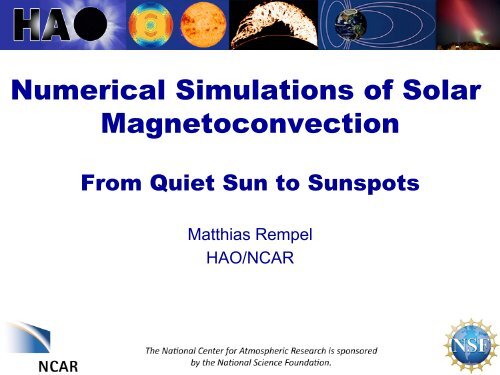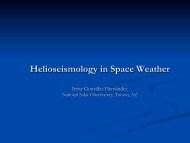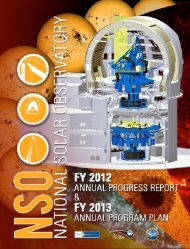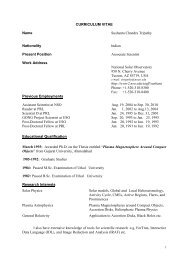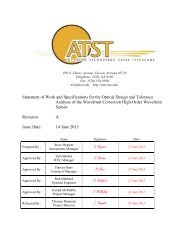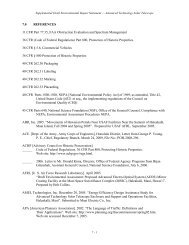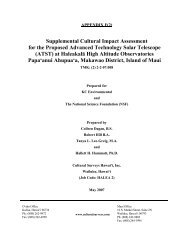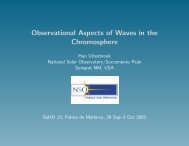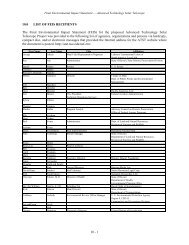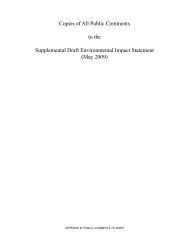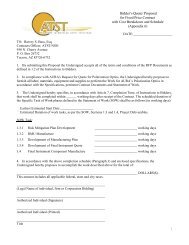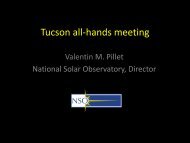Numerical Simulations of Solar Magneto-Convection
Numerical Simulations of Solar Magneto-Convection
Numerical Simulations of Solar Magneto-Convection
You also want an ePaper? Increase the reach of your titles
YUMPU automatically turns print PDFs into web optimized ePapers that Google loves.
<strong>Numerical</strong> <strong>Simulations</strong> <strong>of</strong> <strong>Solar</strong><strong>Magneto</strong>convectionFrom Quiet Sun to SunspotsMatthias RempelHAO/NCAR
“Realistic” magnetoconvectionsimulations• Physical ingredients– MHD (explicit diffusivities or LES approaches)– Equation <strong>of</strong> state (Partial ionization, e.g. OPAL)– 3D radiative transfer (grey, non-grey opacity binning)– Open bottom boundary (attempt to mimic the deep CZ)• Not all physical parameters such as viscosity and magneticdiffusivity are realistic!• First implemented 30 years ago– Nordlund & Stein ….• Changes since then– Computing power, parallelization• Larger domains, higher resolution, longer time scales– <strong>Numerical</strong> schemes• Less diffusion & more stability• Today several independent codes (CO5BOLD, MURaM, Stagger,<strong>Solar</strong>Box)– Good agreement among them (Beeck et al. 2012)NSO Workshop 27 May 7-10, 2013
Sun at 2 km resolution• Simulation domain: 6.144 x 6.144 x 3.072 Mm 3• Grid size: 3072 x 3072 x 1536NSO Workshop 27 May 7-10, 2013
Resolution dependence 32 … 2 km• Converged results using ILES approach– No explicit viscosity or magnetic resistivity– Changing resolution by a factor <strong>of</strong> 16!• Does it converge toward the correct solution (computed with realisticviscosity, resistivity)? …. Ask me in 20 years!– Implicit magnetic Prandtl number ~1– Sun: Pm~10 -5NSO Workshop 27 May 7-10, 2013
Field strength <strong>of</strong> quiet sun?• Depends on bottom boundary condition– B=0, B vertical, B isotropic …?• Upper limit:– B rms should not increase faster with depth than B eq• Lower Limit:– Assume B=0 in all inflow regions• Field strength range: ~30-80 G– Best match with Hinode data ~60 G(Danilovic & Rempel in prep.)NSO Workshop 27 May 7-10, 2013
From granulation to supergranulation• Domain size: 25x25x7.5 Mm 3 , resolution 16x16x16 km 3– Mesogranular magnetic field structure• Longer lived field concentrations and “voids”– Small-scale bipolar flux emergenceNSO Workshop 27 May 7-10, 2013
From granulation to supergranulation• Domain size: 98x98x18 Mm 3 , resolution 64x64x32 km 3– Indication <strong>of</strong> a supergranular network structureNSO Workshop 27 May 7-10, 2013
Stratified convection• Larger scales are anatural consequence <strong>of</strong>stratified convection• Does supergranulationstand out?Stein et al. 2011NSO Workshop 27 May 7-10, 2013
Power spectrum from 2km to 100Mm• Power enhancement aroundsupergranulation scales?– Origin under investigation (PhD <strong>of</strong>Jesse Lord)• Magnetic power spectrum flat onscales larger than granulation• Velocity/field strength spectra– V 30 Mm ~ 500 m/s– V 1 Mm ~ 3 km/s– B 100 km ~ 100 GNordlund et al. 2009NSO Workshop 27 May 7-10, 2013
Flux emergence and active regionformationStein & Nordlund 2012• Large scale flux emergencerequires flux organized on largescales (dynamo)– Stein & Nordlund: 1kG horizontalfield imposed in inflow regions– Cheung & Rempel: activeemergence <strong>of</strong> a semi-torus <strong>of</strong> flux• Both approaches show aqualitative similar behavior in thephotosphere– Appearance <strong>of</strong> mixed polarity– Separation <strong>of</strong> polarities andformation <strong>of</strong> sunspot-like fluxconcentrations• Strong density contrast (10 4 )wipes out dependence onsubsurface structure• Subsurface flow measurementscould tell the differenceRempel & Cheung 2013 (submitted)NSO Workshop 27 May 7-10, 2013
Spontaneous pore formationStein 2012 Kitiashvili et al. 2010• No direct linkage to flux emergence• Form spontaneously if enough flux present in photosphere• No pore formation observed so far in SSD simulationsNSO Workshop 27 May 7-10, 2013
Recent progress in MHD modeling <strong>of</strong>sunspotsSchüssler & Vögler (2006) Heinemann et al. (2007)Scharmer et al. (2008)Kitiashvili et al. (2009)Rempel et al. (2009)NSO Workshop 27 May 7-10, 2013
The imagecannot bedisplayed.Yourcomputermay nothaveThe image cannot be displayed.Your computer may not haveenough memory to open theimage, or the image may have beencorrupted. Restart your computer,and then open the file again. If thered x still appears, you may have todelete the image and then insert itagain.NSO Workshop 27 May 7-10, 2013
Subsurface magnetic field evolution|B| |B| IFixed BOpen-11.5 Mm -3.3 MmNSO Workshop 27 May 7-10, 2013
Subsurface field structure?Monolithic Cluster (Parker 1979)• <strong>Simulations</strong> start with monolithic setup• Fragmentation <strong>of</strong> subsurface field through interaction with ambientconvection– Scale ~ few Mm– Umbral dots have different origin (near surface magneto-convection present inmonolithic background field)• Fragmentation not hidden from surface!– Light bridge formation– Flux separation– Islands <strong>of</strong> granulation• Surface appearance <strong>of</strong> sunspots tells us a lot about subsurface structure– Dark umbrae are only found in more or less monolithic regionsNSO Workshop 27 May 7-10, 2013
Azimuthal averages <strong>of</strong> V R• Radial outflow reaching 25-50% <strong>of</strong>v rms dominant feature• Weak converging cell found ifpenumbra absent• Only outflows in presence <strong>of</strong>penumbra• Thermal signature reaching 50% <strong>of</strong>T rms• No indication <strong>of</strong> bright rings inphotosphereNSO Workshop 27 May 7-10, 2013
Simple model: Flows around obstacle in CZCylinderHeat fluxBlockageCone15 degCone30 degNSO Workshop 27 May 7-10, 2013
Sunspot fine structure: highestresolution• Domain size– 49x49x6 Mm 3• Resolution– 16x16x12 km 3– 3072x3072x512• Sunspot finestructure– Umbral dots– Penumbra– 4km/s Evershed flowNSO Workshop 27 May 7-10, 2013
Sunspot fine structure (at tau=1)NSO Workshop 27 May 7-10, 2013
The magnetoconvection pictureSide viewCentral upflow−rho (v grad) vBx, BzByVx, VzVyzytau=1x−grad p + rho gjxBBVzLateral downflowyPenumbral filament in MHD simulationupdownTop viewxyCross SectionNSO Workshop 27 May 7-10, 2013
MHD simulations and helioseismology• P-modeBraun et al. 2012• Compressibe simulations– f and p-modes arenaturally excited– Realistic power spectra– Can be analyzed like realdata• Sunspots– Shallow origin <strong>of</strong> mosttravel time signatures• Flow inversions– Work in progress– See poster 12 by K.DeGraveNSO Workshop 27 May 7-10, 2013
Summary• Quiet sun magnetism– Small scale dynamo (SSD) sufficient, assuming Pm


